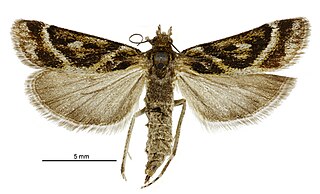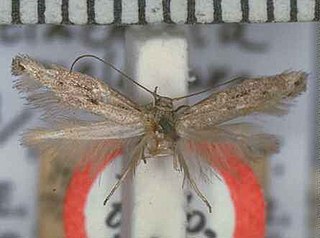
Thectophila is a genus of moths in the family Cosmopterigidae, although some sources place it in the family Blastodacnidae. The genus contains only one species, Thectophila acmotypa. This species is endemic to New Zealand. It is classified as "Data Deficient" by the Department of Conservation.

Stigmella progama is a species of moth in the family Nepticulidae. This species is endemic to New Zealand. It is classified as "Data Deficient" by the Department of Conservation. S. progama has only been collected on Bold Peak in Otago.
Stigmella propalaea is a species of moth in the family Nepticulidae. It is endemic to New Zealand. This species is classified as "Data Deficient" by the Department of Conservation.
Izatha walkerae is a lichen tuft moth in the family Oecophoridae. It is endemic to New Zealand. It is classified as "Data Deficient" by the Department of Conservation.

Circoxena ditrocha is a species of moth in the family Blastodacnidae. This species is endemic to New Zealand and has been collected on both the North and South Islands. The habitat of this species is on the edges of native forest or scrub and it may be associated withPseudopanax arboreus. As at 2000 the host species of this moth is unknown but it has been hypothesised that the larvae are seed borers. Adults are on the wing in December to March. It is classified as "At Risk, Naturally Uncommon" by the Department of Conservation.
Platyptilia hokowhitalis is a species of moth in the family Pterophoridae. This species is endemic to New Zealand. This species has been classified as Data Deficient by the Department of Conservation.
Petasactis is a genus of moths belonging to the family Tineidae. It contains only one species, Petasactis technica, which is endemic to New Zealand. This species has not been collected since prior to 1888. It is classified as "Data Deficient" by the Department of Conservation.

Pyroderces apparitella is a species of moth in the family Cosmopterigidae. It is endemic to New Zealand and has been observed in the North Island where it is regarded by some as being not common. The preferred habitat of this species is native forests and residential gardens. Adults are on the wing in December and January and the species is attracted to light.

Scoparia illota is a species of moth in the family Crambidae. It is endemic to New Zealand. The larvae of this species are leaf miners.

Agriophara colligatella, also known as the Olearia Skeletoniser, is a moth of the family Depressariidae. It is endemic to New Zealand and is found on both the North and South Islands. This species inhabits native scrub. Larvae feed on the leaves of species in the genus Olearia during the months of November and December. They then pupate amongst the old flowers and leaves of their host plant. Adults have been observed on the wing from August to September but are most common in January. It has been hypothesised that this species overwinters as an adult as it has been observed on the wing in late autumn and early winter. Adults are attracted to light.
Phaeosaces lindsayae is a species of moth in the family Depressariidae. It is endemic to New Zealand. It is classified as "Data Deficient" by the Department of Conservation.

Titanomis is a genus of moths containing a single species Titanomis sisyrota, also known as the frosted phoenix. Taxonomists have difficulty placing this moth within an existing superfamily. The species is currently regarded as endemic to New Zealand. Only ten specimens have ever been found and none since 1959; it is classified as "Data Deficient" by the Department of Conservation.

Eudonia ustiramis is a species of moth in the family Crambidae. This species is endemic to New Zealand. It is classified as "Data Deficient" by the Department of Conservation.

Eudonia xysmatias is a moth in the family Crambidae. It was first described by Edward Meyrick in 1907. This species is endemic to New Zealand and has been observed and collected in Otago. This species inhabits wetlands. Adults are day flying and are on the wing in December and January.

Eudonia sabulosella is a species of moth in the family Crambidae. This species is endemic to New Zealand and is regarded as being common. The larvae of this species are known to damage pasture in New Zealand.

Elachista melanura is a species of moth in the family Elachistidae. This species is endemic to New Zealand. It is classified as "Data Deficient" by the Department of Conservation.
Hierodoris sesioides is a species of moth in the family Oecophoridae. It is endemic to New Zealand and is known from its type locality of Esk State Forest in the Hawkes Bay. The host species is Spohora tetraptera, a kōwhai species. The larvae feed internally in woody galls on the stems of this plant. This species is classified as "Data Deficient" by the Department of Conservation.

Lathicrossa prophetica is a species of moth of the family Oecophoridae. It is endemic to New Zealand and has been found in both the North and South Islands. This species inhabits sub-alpine native forest and adults are on the wing in January. It is classified as "Data Deficient" by the Department of Conservation.
Gymnobathra origenes is a species of moth in the family Oecophoridae. This species is in need of taxonomic revision and it has been hypothesised that it belongs to the family Gelechiidae. The species is endemic to New Zealand. It has been classified as Data Deficient by the Department of Conservation. This species is known from only one specimen.
Leptocroca xyrias is a species of moth in the family Oecophoridae. The taxonomy of this species is in need of revision and L. xyrias likely belongs to a separate genus. It is endemic to New Zealand. It has been classified as Data Deficient by the Department of Conservation.











